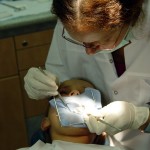
Irrigation procedures and protocols are a key stage in root canal therapy. The aim of this study was to compare the effectiveness of root canal treatments with and without additional ultrasonic activation of the irrigant by evaluating the endodontic outcome.
Patients with a single-rooted maxillary or mandibular incisor, canine, or premolar tooth the required root canal treatment (RoCT) were recruited. Only 1 tooth per patient was included. Pregnant women, teeth with canal curvature >250, or periodontal pockets >3 mm were excluded. Patients were randomised; both groups had syringe irrigation in one group the irrigant was also activated by ultrasound for 10 seconds. The irrigant was 5.25% sodium hypochlorite (NaOCl). Treatment was carries out under rubber dam using a standard protocol. The teeth were examined clinically and radiographically using periapical radiography (PA) and cone-beam computed tomography (CBCT) at first visit and at recall. For the clinical examination, sinus tract, pain, swelling, tenderness to percussion, gingival palpation, and the quality of coronal restorations were recorded.
- 86 (82%) of the 105 patients randomised were reexamined at 10-19 months.
- 3 teeth were considered as treatment failures, 2 from the ultrasonic group and 1 from the syringe group.
- There was no significant difference between the results of the 2 groups with absence and reduction of the radiolucency being observed in 39 of 41 teeth (95.1%) in the ultrasonic group and 38 of 43 teeth (88.4%) in the syringe group (P = .470).
- CBCT detected significantly more post-treatment lesions than PA (P = .038), but the percentages of absence and reduction of the radiolucency together revealed by CBCT and PA were similar (P = .383).
- At recall, the volume of the radiolucencies had reduced by 80%–100% in 54 of 84 teeth (64%),
The authors concluded
Root canal treatments with and without additional ultrasonic activation of the irrigant equally contributed to periapical healing and resulted in a high percentage of absence and reduced lesions.
Comment
It is not clear from the study how many drop-out there were from each group as only data from those completing the trial was reported in the various tables. The study focuses on the radiographic rather then the clinical findings. Interestingly the participants received multiple phone calls to encourage attendance this is an approach which ethical committees in some areas may not support .
Links
Liang YH, Jiang LM, Jiang L, Chen XB, Liu YY, Tian FC, Bao XD, Gao XJ, Versluis M, Wu MK, van der Sluis L. Radiographic Healing after a Root Canal Treatment Performed in Single-rooted Teeth with and without Ultrasonic Activation of the Irrigant: A Randomized Controlled Trial. J Endod. 2013 Oct;39(10):1218-25. doi: 10.1016/j.joen.2013.06.024. Epub 2013 Aug 15. PubMed PMID: 24041381.

@TheDentalElf @Le_Dentist thanks for the suggestion!